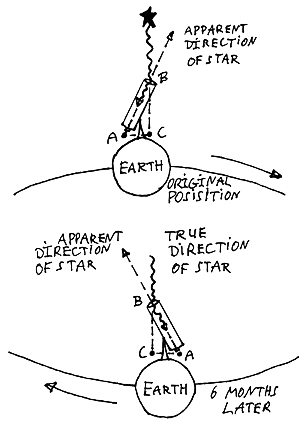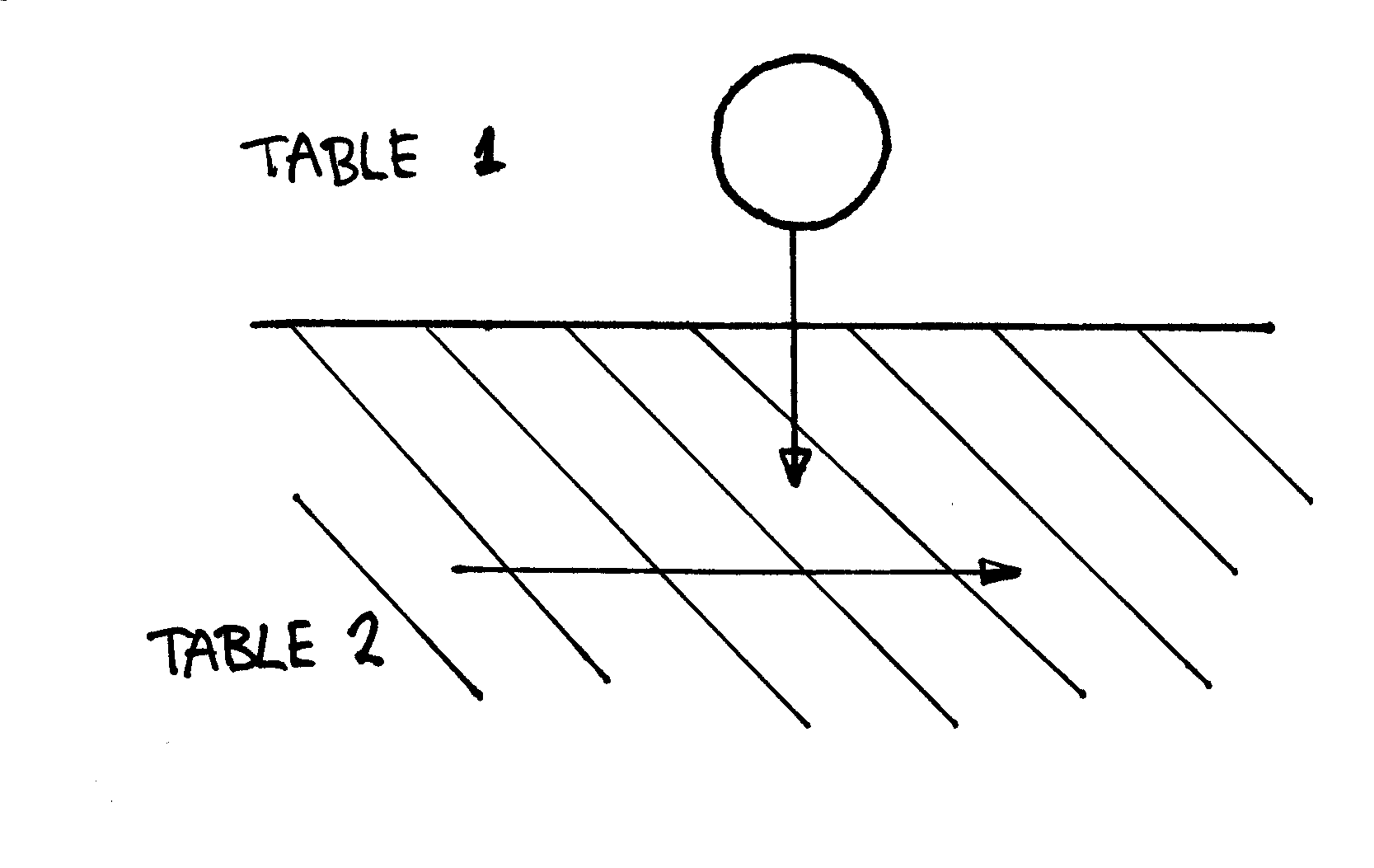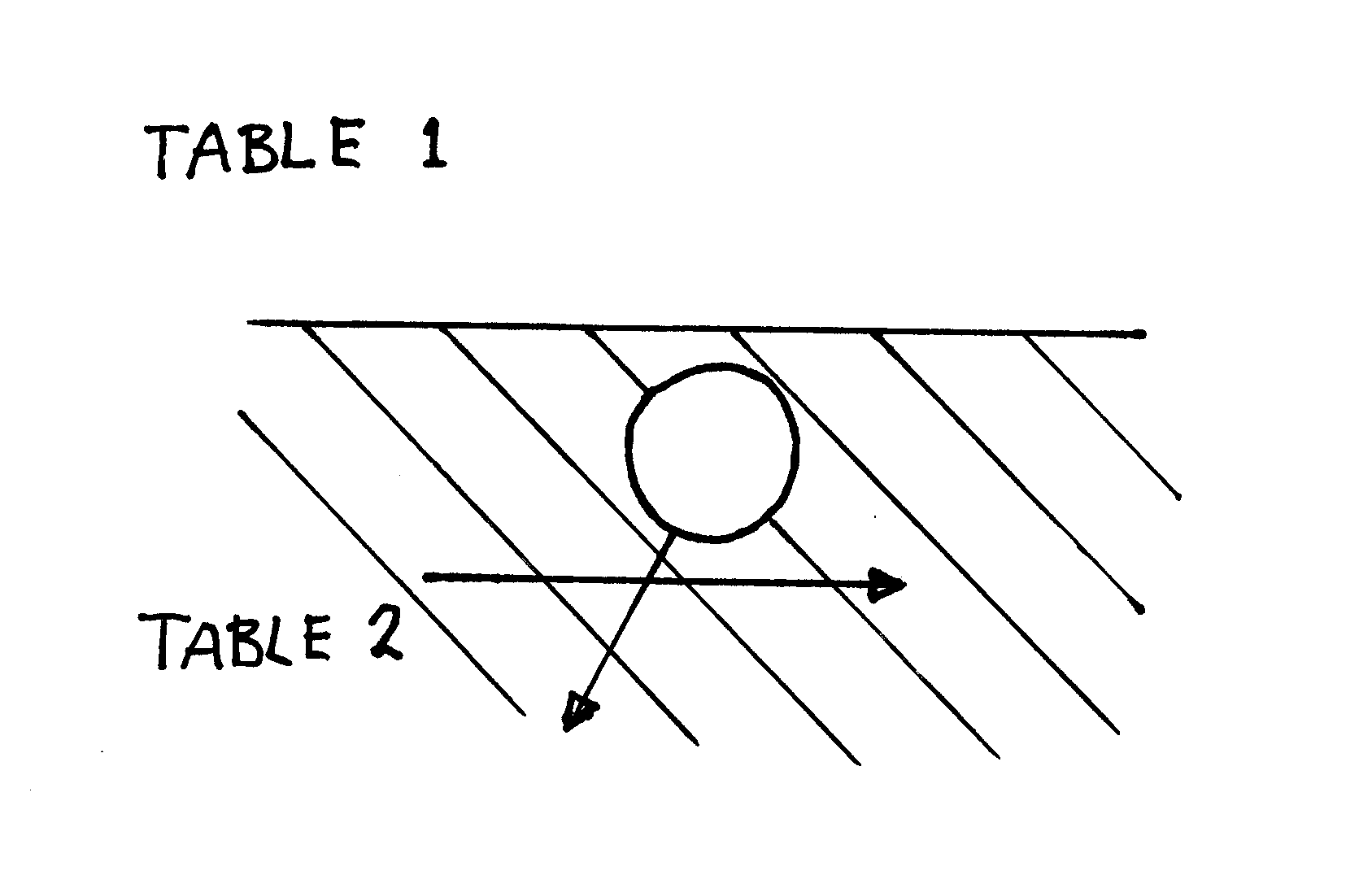James Bradley measured and explained stellar aberration in 1727. Since then conventional science always has explained stellar aberration with Bradley's explanation of the phenomenon. This has led to the dismissal of the Earth-dragging-the-ether and paved the way to the special theory of relativity. However, Bradley's explanation of stellar aberration may be wrong. Stellar aberration can be explained very simple with the Earth-dragging-the-ether. 1727 may be the year of the Historical Mistake.
In 1727 James Bradley, an Englishman, noticed that certain stars appeared to be in a different direction in the sky when looked at 6 months later (see Fig. 1).

Figure 1. Explanation of stellar aberration by Bradley
Bradley called the phenomenon aberration and explained it as follows: while a light wave travels from B to C with 300,000 km/s the telescope moves from A to C with 30 km/s. This still is the way conventional science explains stellar aberration.
Experiments in the nineteenth century with starlight showed that the velocity of light coming from stars always seemed to be constant relative to the Earth: it did not matter if the Earth moved towards a star with 30 km/s or away from a star with 30 km/s, photons always seemed to have the same velocity relative to the Earth.
In the nineteenth century ether theories made furore. In ether theories it was suggested that light moved with a certain velocity with respect to the ether. Some scientists suggested that the apparent constancy of the velocity of starlight with respect to the Earth was caused by starlight photons adjusting their velocity to the velocity of the Earth, or rather: adjusting their velocity to the velocity of the ether dragged by the Earth. However, this Earth-dragging-the-ether was rejected because of Bradley's explanation of stellar aberration.
There is another way of explaining stellar aberration. Take B in Fig. 1 to be the moment that the light wave moves out of the ether drag field of the Sun and into the ether drag field of the Earth. Then the direction of the light wave (the line from the star to B) may change in B because the light wave “crashes” with 300,000 km/s into the Earth's ether field that is moving with 30 km/s from A to C in Fig. 1. And so, because of this crash in, perhaps the light goes from B to A and not from B to C as scientists think since 1727. So, the light may go from B to A while both the telescope and the photon move with 30 km/s along with the Earth, because both are dragged by the Earth respectively the ether of the Earth.
The forces that work on the photon making it change its direction may become easy to understand with a double drag area. The boundary between the ether dragged by the Earth and the ether dragged by the Sun may have an area where a photon is influenced by the ether drag of both the Sun and Earth. In this double drag area the ether of the Sun tries to keep the light wave "at the same track", i.e. on the (wave)line between the star and B in Fig. 1, while the ether of the Earth tries to pull the photon in a perpendicular direction, i.e. right or left in Fig. 1. So in the double drag area there may be a force by the ether of the Sun pulling on the light in the opposite direction than the direction of the ether of the Earth.
Double drag can be see as the combination of two forces like: a raindrop falling down to Earth by gravity while being blown by the wind and so the path of the raindrop to the Earth is tilted. With a photon the path only gets tilted in the double drag area and after the double drag area the photon follows its path in the new direction in the ether of the Earth (without forces of the ether of the Sun). So there does not have to be a force all the time as with a raindrop to keep the path of the photon tilted.
The following may make the double drag reasoning a bit easier to understand. Imagine two tables (tables 1 and 2) next to each other and seen from above. The tables are very long (see Fig. 2). Table 2 is moving from left to right while table 1 stands still. On table 1 a massive iron ball slowly rolls towards table 2. At the moment the ball rolls from table 1 on table 2 there may be two forces working on the ball (imagine the line/boundary between the tables in Fig. 2 to be, in a way, a double drag area): table 1 still has an effect on the ball trying to keep the ball going in the same direction while table 2 tries to take the ball to the right.

Figure 2. Two tables, one moving to the right, one standing still, seen from above with an iron ball rolling over.
The end result may be that the ball changes its direction (as with stellar aberration of a photon) as shown in Fig. 3. And: the faster the speed of the moving table the bigger the aberration of the ball. I think a photon may change its direction because of two forces working on the photon in, what I call, a double drag area.

Figure 3. Two tables, one moving to the right, one standing still, seen from above with an iron ball rolling over.
Though, there is also the inertial force of the rolling ball, as well as there must be a (inertial) force that makes a photon have its speed. So in the case of the iron ball there is an inertial force that makes the ball keep on going on in the same "track", while at the same time friction between table 2 and the ball makes the ball move more and more to the right. In the case of a photon entering the ether field of the Earth there may be a (inertial) force too that makes the photon hold to its original path for a while and then this (too) may explain stellar aberration. Also if a photon is not a particle but a wave in the ether then I think there is still a force that makes the photon/wave “wanting” (by an inertial force) to stay in the same track, while a force attached to the Earth makes the photon go to the right; I think then too the net effect of these two forces may be stellar aberration. (I rather see the photon as a particle, 3-2).
The here mentioned explanations of stellar aberration do not dismiss the Earth-dragging-the-ether. On the contrary, they can be seen as confirmations of the Earth-dragging-the-ether.
Since 1727 not only Bradley's observation of stellar aberration has been taken for the Indisputable Truth, also his 1727 explanation of stellar aberration. Bradley's explanation of stellar aberration may turn out to be the Historical Mistake that has led scientists away from ether concepts and towards the special theory of relativity.